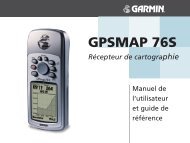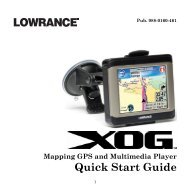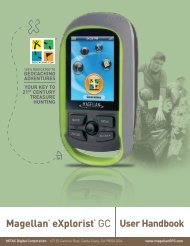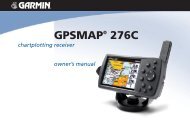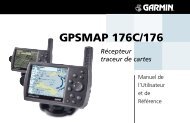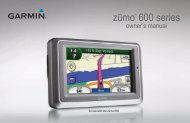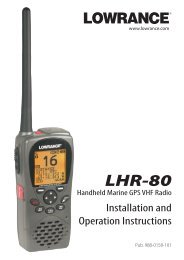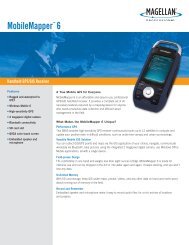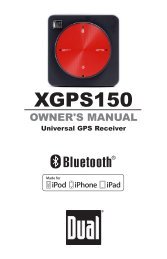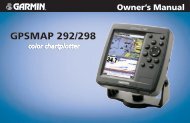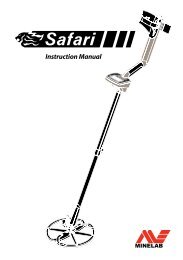Humminbird - Fish Finders and GPS
Humminbird - Fish Finders and GPS
Humminbird - Fish Finders and GPS
You also want an ePaper? Increase the reach of your titles
YUMPU automatically turns print PDFs into web optimized ePapers that Google loves.
Access Under Mounting Location<br />
No Access Under Mounting Location<br />
3. The <strong>GPS</strong> receiver has two wire routing notches. Use the cable notch<br />
closest to the intended cable route.<br />
4. With the cable routed, position the <strong>GPS</strong> receiver in the planned<br />
mounting location <strong>and</strong> mark the mounting holes with a pencil or<br />
punch.<br />
5. Move the <strong>GPS</strong> receiver to the side <strong>and</strong> drill the two 9/64" (3.5 mm)<br />
pilot holes.<br />
No Access Under Mounting Location<br />
Follow these steps to deck mount the <strong>GPS</strong> receiver in a situation where you<br />
must route the cable to the side because there is no space for a cable<br />
underneath the mounting location.<br />
1. Determine the best location, then test route the cable from the<br />
mounting location to the control head.<br />
NOTE: AS-EC10 10' extension cables are available from <strong>Humminbird</strong>® if your<br />
planned routing exceeds 20', (6 m). Maximum cable length, including extensions,<br />
should not exceed 50' (16 m).<br />
2. Confirm the cable length is good <strong>and</strong> route the cable from the<br />
receiver to the control head. If holes are required to route the cable,<br />
they must be 3/4" (19 mm) to allow for the cable connector. Secure<br />
the NMEA pigtail with electrical tape.<br />
6. Align the <strong>GPS</strong> receiver's screw holes over the pilot screw holes <strong>and</strong><br />
attach with the #8 - 1 1/4" Phillips head screws. H<strong>and</strong> tighten only!<br />
Finish Routing the Cable <strong>and</strong><br />
Check <strong>GPS</strong> Receiver Operation<br />
After installing a <strong>GPS</strong> receiver, you should perform the following procedure<br />
to finish routing the <strong>GPS</strong> cable to the control head <strong>and</strong> to check to make sure<br />
that the control head is working correctly.<br />
1. Secure the cable along its path to the control head as needed with<br />
cable ties.<br />
2. Plug the <strong>GPS</strong> receiver cable into the Communications port on the<br />
control head. See Testing the System Installation to use the<br />
System Status start-up option <strong>and</strong>/or the <strong>GPS</strong> Diagnostic View to<br />
confirm a good installation.<br />
NOTE: Remember to caulk or seal screw holes <strong>and</strong> drilled holes as needed to<br />
protect your boat from water damage.<br />
23



